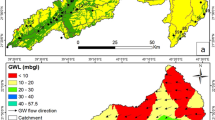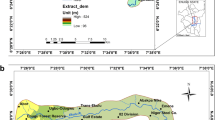Abstract
Heavy metal contamination in the aquatic environment is one of the most serious health issues worldwide. In this study, an evaluation framework is developed to identify the sources and health risk of heavy metals (i.e., As, Hg, Cr, Cu, Zn, Pb, and Cd) contamination in the North Canal of Fengtai District, China, which is based on multiple approaches, including multivariate statistical method, health risk assessment, and uncertainty analysis. Spatial distribution of these heavy metals could exhibit their impact on the aquatic environment. Pearson’s correlation analysis shows that a majority of the correlations between different heavy metals are not significant due to the differences in sources of heavy metals. Principal component analysis indicates that there are four principal components to explain 91.381% of the total variance. Moreover, health risk reveals that hazard quotient values are in low levels, ranging from 0.48 to 0.74, relative higher quotient levels could be observed in the northern section. The carcinogenic risk of Cd has exceeded the acceptable level in S1, S3, and S7. Sensitivity analysis ensures the reliability of health risk assessments. Furthermore, some specific recommendations are given to help decision-makers develop more comprehensive strategies for improving water environment quality.

















Similar content being viewed by others
Data availability
The datasets used and/or analyzed during the current study are available from the corresponding author on reasonable request.
References
Albuquerque MTD, Gerassis S, Sierra C, Taboada J, Martin JE, Antunes IMHR, Gallego JR (2017) Developing a new Bayesian risk index for risk evaluation of soil contamination. Sci Total Environ 603:167–177. https://doi.org/10.1016/j.scitotenv.2017.06.068
Astel A, Tsakovski S, Barbieri P, Simeonov V (2007) Comparison of self-organizing maps classification approach with cluster and principal components analysis for large environmental data sets. Water Res 41(19):4566–4578. https://doi.org/10.1016/j.watres.2007.06.030
Bartoli G, Papa S, Sagnella E, Fioretto A (2012) Heavy metal content in sediments along the Calore river: relationships with physical-chemical characteristics. J Environ Manag 95:S9–S14. https://doi.org/10.1016/j.jenvman.2011.02.013
Bayo J, López-Castellanos J (2016) Principal factor and hierarchical cluster analyses for the performance assessment of an urban wastewater treatment plant in the southeast of Spain. Chemosphere 155:152–162. https://doi.org/10.1016/j.chemosphere.2016.04.038
Chen YZ, Lu HW, Li J, Huang GH, He L (2016) Regional planning of new-energy systems within multi-period and multi-option contexts: a case study of Fengtai, Beijing, China. Renew Sust Energ Rev 65:356–372. https://doi.org/10.1016/j.rser.2016.07.017
Chen YZ, Lu HW, Li J, Ren LX, He L (2017) A leader-follower-interactive method for regional water resources management with considering multiple water demands and eco-environmental constraints. J Hydrol 548:121–134. https://doi.org/10.1016/j.jhydrol.2017.02.015
De Silva S, Ball AS, Huynh T, Reichman SM (2015) Metal accumulation in roadside soil in Melbourne, Australia: effect of road age, traffic density and vehicular speed. Environ Pollut 208:102–109. https://doi.org/10.1016/j.envpol.2015.09.032
Deepa J, Jitendra P (2019) Investigations on peculiarities of land-water interface and its use as a stable testbed for accurately predicting changes in ecosystem responses to human perturbations: a sub-watershed scale study with the Ganga River. J Environ Manag 238:178–193. https://doi.org/10.1016/j.jenvman.2019.02.126
Dehghani S, Moore F, Keshavarzi B, Hale BA (2017) Health risk implications of potentially toxic metals in street dust and surface soil of Tehran, Iran. Ecotox Environ Safe 136:92–103. https://doi.org/10.1016/j.ecoenv.2016.10.037
Delpal I, Florea M, Pelletier G, Rodriguez MJ (2018) Optimizing disinfection by-product monitoring points in a distribution system using cluster analysis. Chemosphere 208:512–521. https://doi.org/10.1016/j.chemosphere.2018.06.009
Devi NL, Yadav IC (2018) Chemometric evaluation of heavy metal pollutions in Patna region of the Ganges alluvial plain, India: implication for source apportionment and health risk assessment. Environ Geochem Hlth 40(6):2343–2358. https://doi.org/10.1007/s10653-018-0101-4
Eze PN, Madani N, Adoko AC (2019) Multivariate mapping of heavy metals spatial contamination in a Cu-Ni exploration field (Botswana) using turning bands co-simulation algorithm. Nat Resour Res 28(1):109–124. https://doi.org/10.1007/s11053-018-9378-3
Habib MA, Islam ARMT, Bodrud-Doza M, Mukta FA, Khan R, Siddique MAB, Phoungthong K, Techato K (2020) Simultaneous appraisals of pathway and probable health risk associated with trace metals contamination in groundwater from Barapukuria coal basin, Bangladesh. Chemosphere 242:125183. https://doi.org/10.1016/j.chemosphere.2019.125183
Haghshenas V, Kafaei R, Tahmasebi R, Dobaradaran S, Hashemi S, Sahebi S, Sorial GA, Ramavandi B (2019) Potential of green/brown algae for monitoring of metal(loid)s pollution in the coastal seawater and sediments of the Persian Gulf: ecological and health risk assessment. Environ Sci Pollut R 27:7463–7475. https://doi.org/10.1007/s11356-019-07481-0
Haris H, Looi LJ, Aris AZ, Mokhtar NF, Ayob NAA, Yusoff FM, Salleh A, Praveena SM (2017) Geo-accumulation index and contamination factors of heavy metals (Zn and Pb) in urban river sediment. Environ Geochem Hlth 39(6):1259–1271. https://doi.org/10.1007/s10653-017-9971-0
Harris MJ, Stinson J, Landis WG (2017) A bayesian approach to integrated ecological and human health risk assessment for the South River, Virginia mercury-contaminated site. Risk Anal 37(7):1341–1357. https://doi.org/10.1111/risa.12691
Hossain MB, Shanta TB, Ahmed ASS, Hossain MK, Semme SA (2019) Baseline study of heavy metal contamination in the Sangu River estuary, Chattogram, Bangladesh. Mar Pollut Bull 140:255–261. https://doi.org/10.1016/j.marpolbul.2019.01.058
Hosseini NS, Sobhanardakani S, Cheraghi M, Lorestani B, Merrikhpour H (2020) Heavy metal concentrations in roadside plants (Achillea wilhelmsii and Cardaria draba) and soils along some highways in Hamedan, west of Iran. Environ Sci Pollut R 27:13301–13314. https://doi.org/10.1007/s11356-020-07874-6
Islam ARMT, Islam HM, Mia MU, Khan R, Habib MA, Bodrud-Doza M, Siddique MAB, Chu R (2020a) Co-distribution, possible origins, status and potential health risk of trace elements in surface water sources from six major river basins, Bangladesh. Chemosphere 249:126180. https://doi.org/10.1016/j.chemosphere.2020.126180
Islam ARMT, Siddiqua MT, Zahid A, Tasnim SS, Rahman MM (2020b) Drinking appraisal of coastal groundwater in Bangladesh: an approach of multi-hazards towards water security and health safety. Chemosphere 255:126933. https://doi.org/10.1016/j.chemosphere.2020.126933
Javadi S, Hashemy SM, Mohammadi K, Howard KWF, Neshat A (2017) Classification of aquifer vulnerability using K-means cluster analysis. J Hydrol 549:27–37. https://doi.org/10.1016/j.jhydrol.2017.03.060
Keller A, Abbaspour KC, Schulin R (2002) Assessment of uncertainty and risk in modeling regional heavy-metal accumulation in agricultural soils. J Environ Qual 31(1):175–187
Liu C, Liu Y, Feng CL, Wang P, Yu LP, Liu DQ, Sun SH, Wang FK (2021) Distribution characteristics and potential risks of heavy metals and antimicrobial resistant Escherichia coli in dairy farm wastewater in Tai'an, China. Chemosphere 262:127768. https://doi.org/10.1016/j.chemosphere.2020.127768
Lu HW, Li J, Ren LX, Chen YZ (2018) Optimal groundwater security management policies by control of inexact health risks under dual uncertainty in slope factors. Chemosphere 198:161–173. https://doi.org/10.1016/j.chemosphere.2018.01.121
Maere T, Villez K, Marsili-Libelli S, Naessens W, Nopens I (2012) Membrane bioreactor fouling behaviour assessment through principal component analysis and fuzzy clustering. Water Res 46(18):6132–6142. https://doi.org/10.1016/j.watres.2012.08.027
Martinez-Cortijo J, Ruiz-Canales A (2018) Effect of heavy metals on rice irrigated fields with waste water in high pH Mediterranean soils: the particular case of the Valencia area in Spain. Agr Water Manage 210:108–123. https://doi.org/10.1016/j.agwat.2018.07.037
Men C, Liu RM, Xu F, Wang QR, Guo LJ, Shen ZY (2018) Pollution characteristics, risk assessment, and source apportionment of heavy metals in road dust in Beijing, China. Sci Total Environ 612:138–147. https://doi.org/10.1016/j.scitotenv.2017.08.123
Nath BK, Chaliha C, Bhuyan B, Kalita E, Baruah DC, Bhagabati AK (2018) GIS mapping-based impact assessment of groundwater contamination by arsenic and other heavy metal contaminants in the Brahmaputra River valley: a water quality assessment study. J Clean Prod 201:1001–1011. https://doi.org/10.1016/j.jclepro.2018.08.084
Pal D, Maiti SK (2018) Seasonal variation of heavy metals in water, sediment, and highly consumed cultured fish (Labeo rohita and Labeo bata) and potential health risk assessment in aquaculture pond of the coal city, Dhanbad (India). Environ Sci Pollut R 25(13):12464–12480. https://doi.org/10.1007/s11356-018-1424-5
Paschoalini AL, Savassi LA, Arantes FP, Rizzo E, Bazzoli N (2019) Heavy metals accumulation and endocrine disruption in Prochilodus argenteus from a polluted neotropical river. Ecotox Environ Safe 169:539–550. https://doi.org/10.1016/j.ecoenv.2018.11.047
Peiris RH, Halle C, Budman H, Moresoli C, Peldszus S, Huck PM, Legge RL (2010) Identifying fouling events in a membrane-based drinking water treatment process using principal component analysis of fluorescence excitation-emission matrices. Water Res 44(1):185–194. https://doi.org/10.1016/j.watres.2009.09.036
Ren LX, He L, Lu HW, Chen YZ (2016) Monte Carlo-based interval transformation analysis for multi-criteria decision analysis of groundwater management strategies under uncertain naphthalene concentrations and health risks. J Hydrol 539:468–477. https://doi.org/10.1016/j.jhydrol.2016.05.063
Saha N, Rahman MS, Ahmed MB, Zhou JL, Ngo HH, Guo WS (2017) Industrial metal pollution in water and probabilistic assessment of human health risk. J Environ Manag 185:70–78. https://doi.org/10.1016/j.jenvman.2016.10.023
Shabanda IS, Koki IB, Low KH, Zain SM, Khor SM, Abu Bakar NK (2019) Daily exposure to toxic metals through urban road dust from industrial, commercial, heavy traffic, and residential areas in Petaling Jaya, Malaysia: a health risk assessment. Environ Sci Pollut R 26(36):37193–37211. https://doi.org/10.1007/s11356-019-06718-2
Sharafi K, Nodehi RN, Yunesian M, Mahvi AH, Pirsaheb M, Nazmara S (2019) Human health risk assessment for some toxic metals in widely consumed rice brands (domestic and imported) in Tehran, Iran: uncertainty and sensitivity analysis. Food Chem 277:145–155. https://doi.org/10.1016/j.foodchem.2018.10.090
Singh UK, Kumar B (2017) Pathways of heavy metals contamination and associated human health risk in Ajay River basin, India. Chemosphere 174:183–199. https://doi.org/10.1016/j.chemosphere.2017.01.103
Swain R, Sahoo B (2017) Mapping of heavy metal pollution in river water at daily time-scale using spatio-temporal fusion of MODIS-aqua and Landsat satellite imageries. J Environ Manag 192:1–14. https://doi.org/10.1016/jjenvman.2017.01.034
Tepanosyan G, Sahakyan L, Belyaeva O, Asmaryan S, Saghatelyan A (2018) Continuous impact of mining activities on soil heavy metals levels and human health. Sci Total Environ 639:900–909. https://doi.org/10.1016/j.scitotenv.2018.05.211
Troldborg M, Duckett D, Allan R, Hastings E, Hough RL (2017) A risk-based approach for developing standards for irrigation with reclaimed water. Water Res 126:372–384. https://doi.org/10.1016/j.watres.2017.09.041
U.S. Environmental Protection Agency Risk Characterization Handbook, Science Policy Council Handbook, EPA 100-B-00-002, 2000
Viswanath NC, Kumar PGD, Ammad KK (2015) Statistical analysis of quality of water in various water shed for Kozhikode City, Kerala, India. Aquatic Procedia 4:1078–1085. https://doi.org/10.1016/j.aqpro.2015.02.136
Wang XY, Xu HZ, Zhou YD, Wu CW, Kanchanopas-Barnette P (2015) Distribution and source apportionment of polycyclic aromatic hydrocarbons in surface sediments from Zhoushan Archipelago and Xiangshan Harbor, East China Sea. Mar Pollut Bull 101(2):895–902. https://doi.org/10.1016/j.marpolbul.2015.10.073
Withanachchi SS, Ghambashidze G, Kunchulia I, Urushadze T, Ploeger A (2018) Water quality in surface water: a preliminary assessment of heavy metal contamination of the Mashavera River, Georgia. Int J Env Res Pub He 15(4):621. https://doi.org/10.3390/ijerph15040621
Yu YJ, Liu LT, Chen XC, Xiang MD, Li ZR, Liu Y, Zeng Y, Han YJ, Yu ZL (2021) Brominated flame retardants and heavy metals in common aquatic products from the Pearl River Delta, South China: bioaccessibility assessment and human health implications. J Hazard Mater 403:124036. https://doi.org/10.1016/j.jhazmat.2020.124036
Zafra C, Temprano J, Suarez J (2017) A simplified method for determining potential heavy metal loads washed-off by stormwater runoff from road-deposited sediments. Sci Total Environ 601:260–270. https://doi.org/10.1016/j.scitotenv.2017.05.178
Zhang YN, Chu CL, Li T, Xu SG, Liu L, Ju MT (2017) A water quality management strategy for regionally protected water through health risk assessment and spatial distribution of heavy metal pollution in 3 marine reserves. Sci Total Environ 599:721–731. https://doi.org/10.1016/j.scitotenv2017.04.232
Zivkovic N, Takic L, Djordjevic L, Djordjevic A, Mladenovic-Ranisavljevic I, Golubovic T, Bozilov A (2019) Pol J Environ Stud 28(3): 2009-2020. https://doi.org/10.15244/pjoes/89986
Funding
This study was financially supported by Key Laboratory of Water Cycle and Related Land Surface Processes, Institute of Geographic Sciences and Natural Resources Research, Chinese Academy of Sciences (No. WL2018003); Scientific and Technological Research Projects of Colleges and Universities in Hebei Province (QN2019054); Science Foundation of Hebei Normal University (L2019B36); Natural Science Foundation of Hebei Province (E2020202117); Science and Technology Project of Hebei Education Department (BJ2020019); Beijing-Tianjin-Hebei Collaborative Innovation Project of Tianjin Science and Technology Plan (19YFHBQY00050); and Second Tibetan Plateau Scientific Expedition and Research Program (STEP) (2019QZKK1003).
Author information
Authors and Affiliations
Contributions
Jing Li: methodology, data curation, writing—original draft and editing; Yizhong Chen: data curation, project administration, resources, writing—review and editing; Hongwei Lu: conceptualization, supervision; Weiyao Zhai: investigation, writing—original draft.
Corresponding authors
Ethics declarations
Ethics approval and consent to participate
Not applicable.
Consent to publish
Not applicable.
Competing interests
The authors declare that they have no competing interests.
Additional information
Responsible Editor: Xianliang Yi
Publisher’s note
Springer Nature remains neutral with regard to jurisdictional claims in published maps and institutional affiliations.
Rights and permissions
About this article
Cite this article
Li, J., Chen, Y., Lu, H. et al. Spatial distribution of heavy metal contamination and uncertainty-based human health risk in the aquatic environment using multivariate statistical method. Environ Sci Pollut Res 28, 22804–22822 (2021). https://doi.org/10.1007/s11356-020-12212-x
Received:
Accepted:
Published:
Issue Date:
DOI: https://doi.org/10.1007/s11356-020-12212-x




